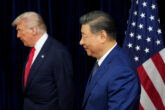August 30, 2021
The Missing Context in America's Competition with China
“What does winning this competition with China look like? When can we say we won?” A colleague from a fellow think tank posed these straightforward but weighty questions while we were waiting our turn at a lunch buffet. It was my first in-person conference in well over a year and exactly the kind of moment that the myriad of virtual gatherings many of us have sat through the past year and a half can’t capture. A spontaneous, insightful remark on the margins of a thought-provoking gathering to discuss the future of US-China relations. Coming up with an answer is not an exercise in Beltway wonkery — the eventual answer will have a profound long-term impact on all facets of American society.
Answering that question means articulating a strategic vision for the United States, a vision with a timeline of decades. That objective, and the actions American society will need to take to achieve it, will have outsized influence over US foreign, domestic, and economic policies for generations. President Joe Biden and Congress are taking important initial steps, such as addressing supply chain vulnerabilities, boosting R&D funding, and engaging with allies. Leaders from civil society and industry are producing untold recommendations ranging from tax incentives to new government agencies to moonshot technology development efforts.
We need to drop the talk of a new “cold war” to describe the tense us-china rivalry. It isn’t one. Instead, it’s an unprecedented contest between two economic powerhouses with widespread interdependencies.
Missing, though, is the overarching context in which these actions should take place. The US government needs to articulate a national technology strategy for an era of sustained competition with a highly capable contender. A national technology strategy includes how the US invents, innovates, and deploys technologies — such as biotech, quantum computing, microelectronics, energy storage, etc. — to compete economically while securing its national interests. In a recent report, Megan Lamberth and I make the case for the United States crafting, executing, and updating its technology policies via a comprehensive framework. The goal, and the answer to my colleague’s questions, should be this: To maintain the United States’ standing as the world’s premier technology power so that it can empower its citizens, compete economically, and secure its geostrategic interests without having to compromise its values or sovereignty.
Read the full article from Inkstick.
More from CNAS
-
Transatlantic Security / Technology & National Security
Look Before We Leap on Artificial IntelligenceThis article was originally published on The Dispatch. A debate about the role that artificial intelligence should and will play in society, and how it will affect humanity fo...
By Jon B. Wolfsthal
-
Technology & National Security
Caleb Withers on the Cybersecurity Frontier in the Age of AICaleb Withers, research associate at the Center for a New American Security, joins Kevin Frazier, the AI Innovation and Law Fellow at the University of Texas School of Law and...
By Caleb Withers
-
Technology & National Security
Prepared, Not ParalyzedExecutive Summary The Trump administration has embraced a pro-innovation approach to artificial intelligence (AI) policy. Its AI Action Plan, released July 2025, underscores t...
By Janet Egan, Spencer Michaels & Caleb Withers
-
Indo-Pacific Security / Technology & National Security
Sharper: Tech + ChinaRecent talks between President Donald Trump and Chinese Communist Party General Secretary Xi Jinping placed a spotlight on emerging technologies, from high-end chips to minera...
By Charles Horn & Sevi Silvia




